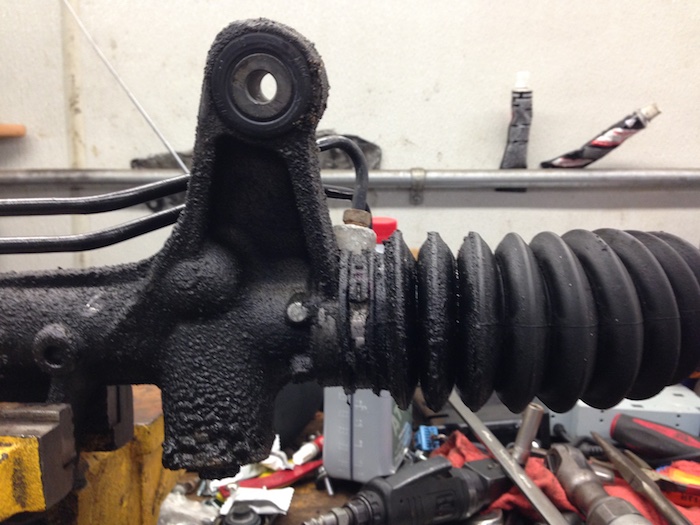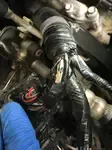This Site Was Built With You In Mind!
Common Car Leaks, and How to Diagnose Them.
by Eddie Carrara
I have been turning wrenches in the automotive business since 1986. My title is an ASE-Certified Master Technician, my mission is to help you understand the machine you drive every day and help save you some money along the way. If you find this site helpful, please comment and share the information.
|
Your car leaks, and you're not sure what's leaking, you're starting to panic. Will I break down? Will I be left stranded? Will I make it to work on time? Are my kids safe? Is my car going to blow up? These are just a few of the thoughts that might be going through your mind when you see fluid leaking from your vehicle. |
At one time, it was easy to figure out what is leaking from your car just from the color of the fluid. Now it's almost impossible because the fluid colors have all changed. Coolant was only green at one stage of the game, now it comes in various colors, from green, orange, pink, even purple.
So how do you know what fluid is leaking from your car? It all boils down to the process of elimination. We will look at color, texture, and smell; we will also look at the area from which the leak is coming to help you decide what's causing the leak.
Car Leaks Coolant?
What Color is Coolant/Anti-freeze?
What Does it Smell Like?
Engine coolant comes in a rainbow of colors because car manufactures have branded their coolant to make a few extra bucks. Every manufacturer has its brand coolant with their label on it. Branding makes it a bit harder to go to the local auto part store and buy a gallon of generic coolant.
If your car leaks and you need to add coolant to your engine/radiator, it's a good idea to stick with the same brand so the colors don't get mixed and cause you to have brown coolant. Remember how you use to mix your watercolor paints when you were a kid? The same thing will happen in your radiator if you're not careful. Check your coolant color first before you buy; look inside your overflow tank to verify the color.
If you were to put coolant on your finger, you'll notice it has an oily feeling to it, but not like engine oil, more like soap or shampoo, and it rinses off easily, unlike motor oil. If you were to smell coolant, it smells sweet like candy, and it even has a sweet flavor because it's wood alcohol (don't ask how I know what it tastes like).
If you suspect your car leak might be coolant, try to locate where it's coming from, the most common area for a coolant leak is the front of the vehicle, right under the radiator, but coolant could leak from anywhere, even inside your car. If you have to add coolant to your radiator, be sure to add a 50/50 mix of coolant and water.
Some coolant's come premixed to make it easy for the consumer. If you happen to buy 100 percent coolant, I recommend checking the coolant's concentration level with a hydrometer. Even if you live in an area that never gets cold, you need to have a mixture of water and coolant to protect your engine from corrosion and overheating, so have an Engine Coolant Hydrometer in your toolbox, their cheap and they don't go bad.
|
If you have a coolant leak in the radiator or heater core, I recommend using a Bar's liquid stop leak for a temporary fix. Bar's leak is one of the better stop leak products because it will not clog your radiator or heater core like other stop leak products. Using Bar's leak will buy you some time until you have the money to repair the leak properly. |
Car Leaks Oil?
What Color is Oil?
What Does it Smell Like?
Maybe your car leaks oil? First, pull the engine oil dipstick and check to see what color your oil is. Motor oil is generally gold in color, but it depends on the brand. Some brands are very dark amber, like a lager beer. The texture is very slippery on your fingers, and it won't be easy to wash off. You will need soap to wash it off.
Motor oil has a smell like burnt butter or cooking spray, like when you turn the stove burner on high, and the pan starts to smoke. Engine oil gets extremely hot and has that burnt smell to it with a fuel hint, especially motor oil, at the end of its life.
Motor oil tends to get very dark when it is in an engine for a long time because it collects unburned gases and debris from the engine; this causes the oil to become dark and a few other factors. Motor oil has a very unpleasant taste as well; again, don't ask!
Some of the most common oil leaks areas are the valve cover gaskets, timing covers, oil filters, and oil drain bolts. If you suspect your car leaks oil, place a piece of cardboard under your car and try to pinpoint the area where the leak occurs. Even if you don't plan to fix it yourself, you can let your mechanic know where the leak is coming from; it will save the mechanic time and your money.
If your car leaks oil and you can't seem to locate the point of origin, try using Tracer Products TP34000601 UV Fluorescent Leak Detection Dye - Set of 6, but you will also need this Uview 413010 Battery Powered, 6 LED Leak Detection Light. I use this die and light to find those tough leaks that have me scratching my head.
What Color is Automatic Transmission Fluid?
What Does it Smell Like?
If your car leaks automatic transmission fluid, don't confuse it with power steering fluid. Automatic transmission fluid is red or pink unless it's aged severely and abused, then it tends to be brown or dark gray. If your transmission fluid is another color other than red or pink, I recommend changing it. It will improve the shift quality and the life of your transmission.
Automatic transmission fluid is very slippery to the touch, and it smells a little like cooking oil. You will need soap and water to remove it from your hands. The most common transmission fluid leak is an axle seal or an output shaft seal. If you think your car leaks transmission fluid, again, place a piece of cardboard under your transmission to locate the leak.
For information on transmission fluid leaks, go to Car Leaks Red Fluid.
What Color is Brake Fluid?
What Does it Smell Like?
If you think your car leaks brake fluid, Don't drive it; tow it! Brake fluid is clear, sometimes with a tint of amber, but very faint. Brake fluid has a dry, oily feeling like dry tanning spray, and it's is very corrosive to paint.
If you ever spill brake fluid on your car paint or even if you transfer it from your hands to the paint, remove it as fast as you can with window cleaner or windshield washer fluid. It will neutralize the corrosive properties in the brake fluid and will stop it from destroying your paint.
Brake fluid has a funny smell; it smells a little like fish oil or castor oil. If the brake fluid is old, the brake fluid in the reservoir will turn green because brake fluid attracts moisture, so the water trapped in the brake fluid reservoir will have algae sediment in it.
Cleaning the brake fluid reservoir is easy. Simply break out a turkey baster, suck the old fluid out of the reservoir, then replace it with new brake fluid. If you're a mechanic or work on cars often, I highly recommend buying this Mityvac MV6835 Vacuum Brake Bleeding Kit. I am the only one in the shop who owns this mini vacuum kit, and everyone want's to borrow it. It works on all fluids, and I use it multiple times a day.
The most common brake fluid leaks are flex lines and master cylinders. If your master cylinder is leaking, it will usually drip brake fluid into the car near the brake pedal. If a brake flex line, caliper, or wheel cylinder is leaking, it will leak at or near a hub.
What Color is Power Steering Fluid?
What Does it Smell Like?
What if your car leaks power steering fluid? How would you know? Some manufactures use transmission fluid as power steering fluid, but you can buy steering fluid especially made for power steering systems; it's called, you guessed it, Power steering fluid!
Power steering fluid has a unique smell; it reminds me of how a marshmallow smells when it catches on fire, so it has a burnt smell, and no, I don't know what it tastes like, but I'm sure it doesn't taste like a burnt marshmallow.
The most common leak in a power steering system is usually at each end of the steering rack, at the rack end seals, if you have rack and pinion steering. If your vehicle has a steering gearbox, generally, the fluid leak would be at the seal at the bottom of the steering gearbox, but most vehicles on the road today have rack and pinion steering.
If you suspect the power steering leaks, look at the steering rack boots, notice if they're wet with power steering fluid. If they are, you may need to replace the complete steering rack.
For information on power steering fluid leaks, go to Car Power Steering leaks.

In the above picture is a leaking power steering rack that is out of the vehicle. Typically you'll see the rubber boot start to discolor because of the power steering fluid trapped behind it. Eventually, it will seep through the rubber boot and start dripping on the ground.
What Color is Differential Fluid?
What Does it Smell Like?
Is your car leaking Differential fluid? Differential fluid is a very thick and stinky lubricant. If you get it on your hands or your skin, you will smell it for days. Differential fluid is the color of honey, and it's just as thick. Old differential fluid tends to turn gray because of the metal dust mixed with it from the gears meshing. I don't have a description of the smell. All I can say is it is very intense.
The most common leaks of differential fluid would be the axle seals and the pinion seal. If you think you may have an axle seal leaking, it's a good bet that you will see fluid leaking at the hub area near the wheel bearing, and if the pinion seal is leaking, it will be leaking near the u-joint closest to the deferential.
Conclusion
Well, I covered all the possible car leaks here by describing what their color could be and how they smell.
If you have any questions, please ask. There are no stupid questions when it comes to vehicles; plus, someone else might have the same problem and is too scared to ask, so ask.
This article is accurate and true to the best of the author’s knowledge. Content is for informational or entertainment purposes only and does not substitute for personal counsel or professional advice in business, financial, legal, or technical matters.
If you have a question or comment, just ask.
Leave Car Leaks page and return to Simple Car Answers Home page


